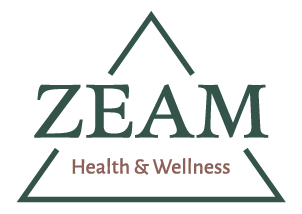As the leaves change color and the days grow shorter, many of us find ourselves feeling a bit more melancholic than usual. This shift in mood isn’t just a coincidence. It’s often a sign of Seasonal Affective Disorder (SAD), a type of depression that occurs at the same time each year, especially during the fall and winter months. SAD is more than just the winter blues. It’s a condition that can significantly impact one’s energy levels, appetite, sleep patterns, and overall sense of well-being.
Understanding SAD is crucial, not only for those who experience it directly but also for their loved ones. Recognizing the signs and symptoms of this seasonal depression is the first step toward managing its effects. At Zeam Health & Wellness, we believe in the power of awareness and education to empower individuals to take control of their mental health. By shedding light on SAD, we aim to provide valuable insights and strategies to help navigate these challenging seasonal changes, ensuring a path toward a healthier, more vibrant life regardless of the season.
Understanding Seasonal Affective Disorder (SAD)
Definition and Symptoms of SAD
Seasonal Affective Disorder (SAD) is a form of depression that cyclically arises as the seasons change, predominantly affecting individuals in the fall and winter months. This condition manifests through a constellation of symptoms that mirror those of major depression but occurs at a specific time of year. Individuals may experience deep sadness, loss of interest in activities once enjoyed, significant changes in appetite or weight, and overwhelming fatigue. The need for depression treatment options becomes paramount for those grappling with SAD, as it significantly impacts daily functioning and overall quality of life.
Causes and Risk Factors
The exact cause of SAD remains the subject of ongoing research, but the condition is closely linked to the reduced level of sunlight in autumn and winter. This decrease in sunlight can disrupt our biological clock or circadian rhythm, leading to feelings of depression. Additionally, the change in seasons can spark a drop in serotonin, a neurotransmitter that regulates mood, further exacerbating depressive symptoms. Melatonin levels, which affect sleep patterns and mood, may also become imbalanced. Genetic predispositions, along with these environmental factors, play a crucial role in the onset of SAD, making it vital for individuals to understand their risk and seek appropriate treatment as the seasons change.
Diagnosing SAD
Overview of the Diagnostic Process
Identifying Seasonal Affective Disorder (SAD) involves a meticulous diagnostic process underscored by the expertise of healthcare professionals. This critical evaluation begins with a comprehensive review of the individual’s medical history, coupled with an in-depth discussion of their symptoms. The hallmark of SAD—its recurrence at specific times of the year—sets it apart from other forms of depression. Professionals rely on specific criteria to diagnose this condition, including the timing of depressive episodes and their resolution in line with seasonal changes.
A key component of this process is the development of a depression treatment plan tailored to the individual’s unique needs. This plan is pivotal, as it outlines the therapeutic approach and interventions designed to alleviate the symptoms of SAD. The emphasis on professional evaluation ensures that the diagnosis is accurate, enabling individuals to receive the most effective treatment. At Zeam Health & Wellness, we advocate for early and professional assessment to pave the way for a comprehensive and personalized treatment plan, offering a beacon of hope for those navigating the challenges of SAD.
Treatment Options for SAD
Light Therapy (Phototherapy)
Light therapy emerges as a ray of hope for individuals facing Seasonal Affective Disorder (SAD). By simulating natural sunlight through artificial light exposure, this approach tackles the reduced sunlight of the shorter, darker days. Its simplicity and efficacy in easing symptoms render it a fundamental strategy in combating SAD.
Medication and Vitamin D
Antidepressants play a pivotal role in the depression treatment plan for many individuals facing SAD. These medications, particularly selective serotonin reuptake inhibitors (SSRIs), can help correct the neurotransmitter imbalances that contribute to seasonal depression. Vitamin D supplementation emerges as a critical ally. Given its role in serotonin activity, Vitamin D can counteract the sunlight scarcity of winter months, offering a dual approach to treatment that many find indispensable. Depression treatment centers often advocate for a comprehensive strategy that includes both medication and Vitamin D to tackle SAD from multiple angles.
Psychotherapy and Lifestyle Changes
Cognitive Behavioral Therapy (CBT) is another cornerstone of SAD management that provides strategies to combat the negative thought patterns associated with this condition. Coupled with lifestyle modifications, such as regular exercise and a balanced diet, CBT can significantly enhance one’s ability to manage SAD. Physical activity stimulates endorphins, while a nutritious diet supports overall brain health, together fostering a holistic approach to well-being. At Zeam Health & Wellness, we emphasize the synergy of psychotherapy and lifestyle changes as a powerful formula for not just coping with SAD but thriving despite it.
Preventing SAD: Strategies and Tips
Embracing a proactive stance toward Seasonal Affective Disorder (SAD) can significantly diminish its impact, fostering a sense of control and well-being even during the darker months. At Zeam Health & Wellness, we advocate for a holistic approach to prevention, emphasizing the synergy between mind, body, and environment.
Firstly, maximizing exposure to natural light is paramount. Make your living spaces bright and airy, and position your workspace near windows to soak in as much daylight as possible. For those darker times, consider light therapy—a proven method to simulate the uplifting effects of sunlight.
Engaging in regular physical activity is another powerful preventive measure. Exercise not only boosts your mood through the release of endorphins but also supports overall physical health, which is intricately linked to mental well-being.
Nutrition cannot be overlooked. A diet rich in omega-3 fatty acids, whole grains, and fresh produce can support brain health and mitigate some of the depressive symptoms associated with SAD.
Lastly, maintaining a robust social network and seeking support when needed can provide a buffer against the isolating effects of SAD. Whether through community involvement, online forums, or therapy, staying connected is key.
Take Action Against Seasonal Affective Disorder
In the battle against Seasonal Affective Disorder, taking the first step toward healing is crucial. At Zeam Health & Wellness, we stand ready to guide you through the darkness toward the light. Don’t let SAD dictate your life’s rhythm. Whether you’re searching for depression treatment near you or specifically seeking depression treatment in Sacramento, we’re here to offer the support and expertise you need. Embrace the journey to reclaim your joy and vitality. Contact Zeam Health & Wellness today, and let’s illuminate your path to recovery together. Your brighter days are ahead.




